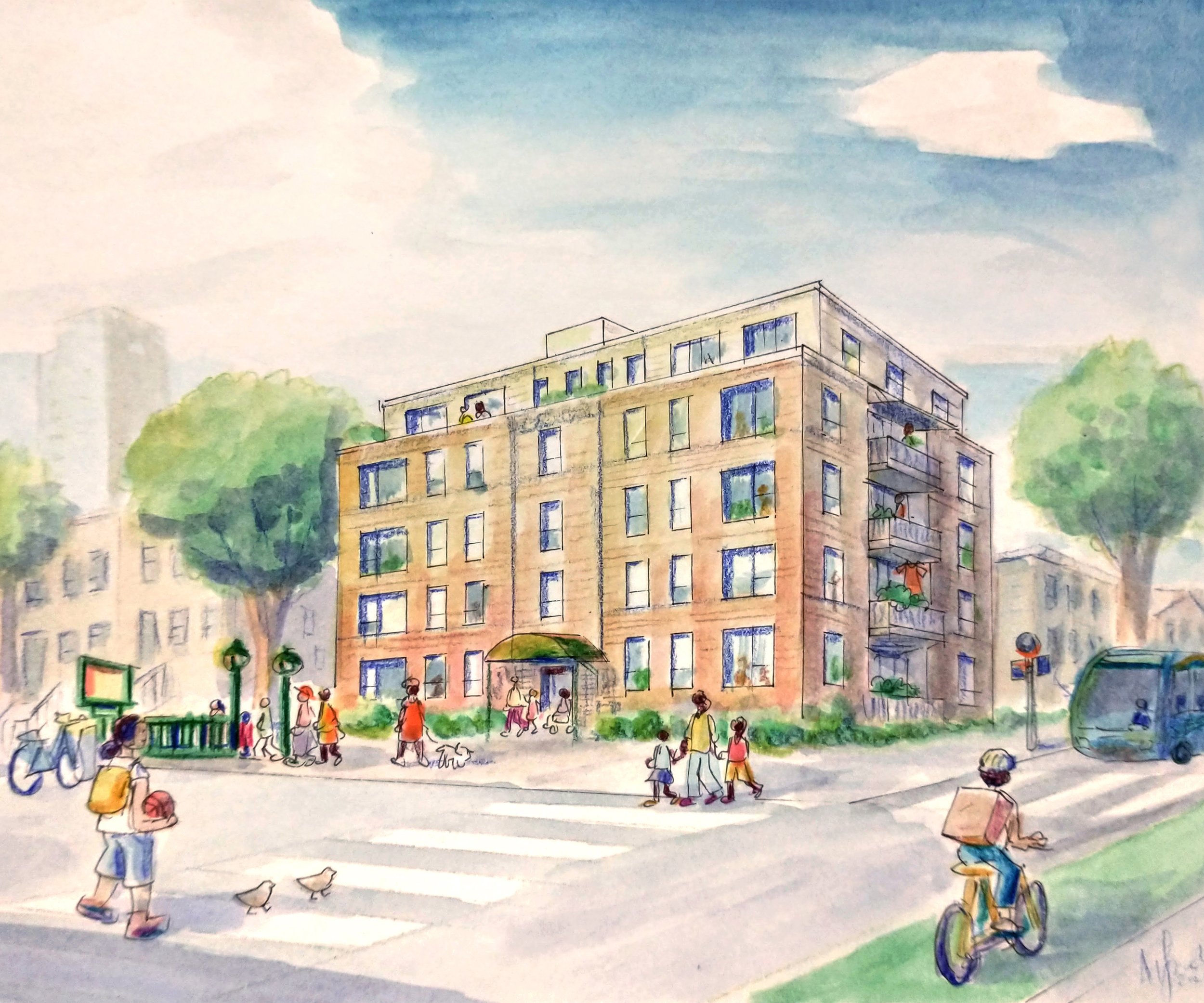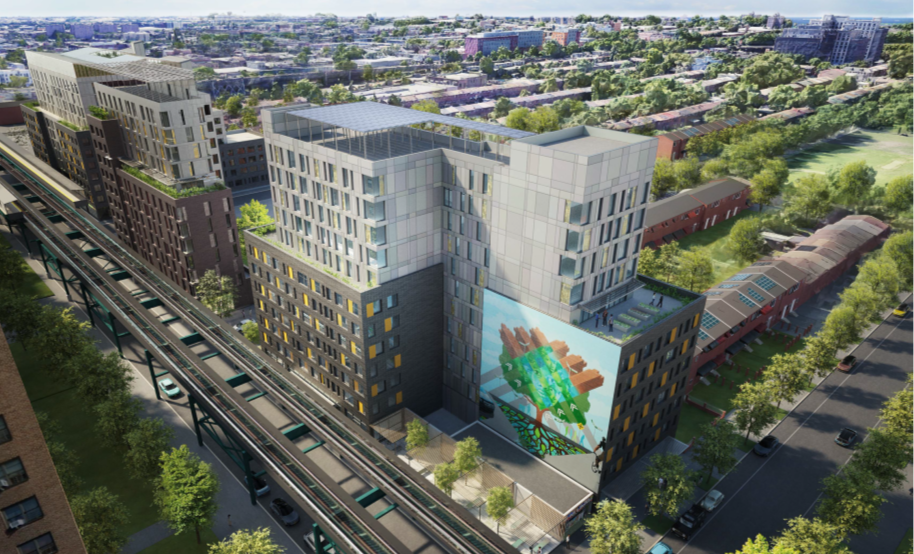Housing
Housing availability and affordability are not only vital to the city’s Capital Strategy — they are vital to the future of New York City itself. Producing more housing and promoting housing affordability will require a broad array of policy adaptations, thoughtful planning, and strategic investment in infrastructure to support necessary and projected growth.
In the face of a significant housing shortage, building more homes is critical to providing New Yorkers with more housing options and lowering housing costs. The city’s Capital Strategy reflects a commitment to thoughtful planning and strategic investments to support this growth. The recent adoption of the City of Yes for Housing Opportunity zoning amendment marks a historic step forward by unlocking opportunities for a range of housing types, including income restricted affordable homes, across the city. Complementary investments in housing and infrastructure will ensure the city can support this growth effectively and equitably. The City’s capital strategy also reflects the importance of maintaining existing affordable housing assets through investments in preservation programs.
Planning for changes in housing development
Housing growth is an important catalyst for capital projects. The city closely monitors anticipated housing developments to ensure residential capital investments — such as schools, sewers, and parks — have the capacity to accommodate anticipated housing changes at the neighborhood level.
Between 2010 and 2025, New York City experienced a net increase of 322,000 housing units. Net increases in units have been concentrated in both transit accessible neighborhoods and formerly non-residential areas that were rezoned to allow residential construction. In these transit-accessible neighborhoods, the city is making targeted improvements to transit stations and area transportation options. In formerly non-residential areas, the city is investing in schools, libraries, and open space to address the new needs of a residential population.
The city’s planned neighborhood-wide rezonings are conducted in coordination with city agencies with the goal of anticipated residential housing growth being supported by capital investments.
Nearly 34,000 market rate and affordable housing units were completed in 2024, the most in over a decade. This production increase mirrors the growth in housing construction permits in 2022, due to an effort by developers to vest under the expiring 421-a property tax exemption program. Community districts along the East River in Brooklyn and Queens, as well as those on the west side of Midtown Manhattan have led the city in new housing development. The city’s growing population and rising housing costs point towards the continuation to add to the housing supply and to make commensurate infrastructure investments.
City of Yes for Housing Opportunity (CHO)
New York City is in the midst of a housing crisis and combatting this crisis requires an all-hands-on-deck approach. In 2024, New York City took a significant step forward with the passage of City of Yes for Housing Opportunity, a set of citywide zoning changes to enable “a little more housing in every neighborhood.” This strategy was specifically designed to encourage more equitable, balanced growth across the city, removing historical barriers to housing opportunity and reducing the pressures that occur when new housing is concentrated into just a few neighborhoods.
City of Yes for Housing Opportunity included several significant changes to the city’s zoning, to allow for more flexible housing creation that responds to the needs and demands of the city today.
Missing Middle Housing
New York City has an incredibly diverse stock of mid-rise multi-family housing in its low-density neighborhoods. Unfortunately, many of these building types were not possible to build under restrictive zoning that was implemented in 1961 and modified over time. The City of Yes initiative revised residential zoning to once again make it possible to build modest apartments on select sites: in particular, on large lots near transit as a part of the “Transit-Oriented Development” component, and on commercial corridors as a part of the “Town Center” component. Importantly, this approach fits into the existing context, allowing for new development that matches the scale and character of existing buildings that had been effectively banned by zoning.
Universal Affordability Preference (UAP)
City of Yes allows buildings in medium and high-density zoning districts (R6-R10) to add at least 20% more housing if the additional homes are permanently affordable. These affordability bonuses allow greater affordability across a greater area of the city. For reference, the predecessor to UAP, Voluntary Inclusionary Housing, applied to only 13% of medium and high-density zoning districts, whereas UAP applies to 100%.
New Housing Parking Requirements
New York City’s parking mandates have long required new housing to include parking, even where it isn’t needed. These inflexible requirements increase the cost of housing developments, reduce the total number of units feasible in a given project, and drive-up housing costs for residents overall. City of Yes has rolled back parking mandates via a three-zone system in which parking mandates were either removed, reduced, or maintained. This approach allows for a context-sensitive revision of parking mandates to help generate numerous more affordable homes.
Accessory Dwelling Units (ADUs), Small and Shared Apartments
Increasing the diversity of the housing supply is integral to combatting the housing crisis and providing the types of housing that is in demand. To help diversify housing stock, one and two-family homeowners in all residential districts can now create ADUs such as backyard cottages or “in-law units,” offering more flexibility for multigenerational families, rentable space, and other scenarios. Similarly, City of Yes allows buildings in higher-density districts to have more studios and one-bedrooms by lowering and standardizing the dwelling unit factor, creating a wider variety of housing options for people who want to live alone, reducing pressure on larger units that are suitable for family occupancy.
Height-Limited, Contextual Infill
City of Yes removes zoning obstacles and streamlines outdated rules to make it easier for campuses (excluding NYCHA) to infill with new contextual, height-limited buildings. These new infill rules are crafted to protect green and recreational spaces like playgrounds, while still allowing for greater residential density.
Each of these proposals aims to strategically increase housing production in a different way, with emphasis placed on retaining affordability and producing housing for all New Yorkers.

- Illustration credit: Alfred Twu
Providing affordable housing for low and moderate-income New Yorkers
The Housing Blueprint ties together the work of the Housing Development Corporation (HDC), HPD, NYCHA, the Department of Small Business Services (SBS), and many other city agencies, to break down silos and address housing issues in a more holistic way. Whether it’s public housing or affordable housing, homelessness or homeownership, city services should work together to serve New Yorkers where they are and where they want to go. The Housing Blueprint is the city’s equitable vision to tackle New York City’s affordable housing crisis and get New Yorkers into the safe, high-quality, affordable homes they deserve. The Housing Blueprint sets a plan to transform NYCHA: to improve services, create and preserve affordable and supportive housing, improve housing quality, sustainability, and resiliency, and remove administrative burdens so New Yorkers can get the help they need.
The city is also working to promote housing growth that allows low-income New Yorkers to choose housing based on key factors like access to transit, schools, and job centers. HPD’s Where We Live NYC plan presents strategies to increase housing opportunities in amenity-rich neighborhoods. Such strategies include identifying opportunities to increase the supply and diversity of low-cost housing in lower-density neighborhoods, increase the floor area for buildings that provide affordable housing units, and legalize basement apartments and other accessory dwelling units. These strategies will work with the City of Yes for Housing Opportunity to expand the diversity and affordability of our housing stock.
To carry out these two plans, the city is investing $21.1 billion in HPD’s ten-year capital strategy, including $8.1 billion for new construction. Funding will support construction of new units serving New Yorkers at a range of income levels, ranging from extremely low income to middle income, throughout the five boroughs. The TYCS also provides $5.9 billion for preservation projects. Funding will support activities to preserve existing affordable housing stock while creating long-term affordability. Additionally, $4.6 billion is allocated for the construction and preservation of housing for seniors, persons with disabilities, and formerly homeless households throughout the five boroughs.
HPD Investment for Affordable Housing Creation
HPD is constantly working to create affordable housing opportunities through varied investment strategies and programs. The following three projects are current examples of investments using the Mix and Match term sheets, Participation Loan Program, and Senior Affordable Rental Apartments term sheets.
Willets Point, Buildings 1 and 2
These two buildings, located within the Willets Point Phase I Development, will bring two new construction, multifamily affordable housing developments to the Willets Point Peninsula. They will include a total of 881 units all financed with HPD’s Mix and Match term sheet. This program funds new construction of mixed income multi-family rental projects where 40%-60% of the units are at low-income rents affordable to households earning up to 80% of the Area Median Income (AMI), and the remainder of the units have rents affordable to moderate income households earning up to 120% of AMI. The development will be part of a larger redevelopment of the peninsula with a professional soccer stadium, a 650-seat public school, a hotel, retail, additional affordable housing, and open space and public realm improvements.

- Images credit: S9 Architecture, 2023
Livonia C3
At the cutting edge of sustainable environmental design and community support, Catholic Charities Progress of Peoples Development Corporation (CCPOP) is building a 13-story, 142-unit Senior Housing Project in Brownsville, Brooklyn, as part of HPD’s Senior Affordable Rental Apartments term sheet. The project, developed as part of a comprehensive community vision through HPD’s Brownsville Plan, is leveraging New York State Energy Research and Development Authority (NYSERDA) Building of Excellence funds, and will be all-electric. The development will include an approximately 10,000 square foot, public-facing Older Adult Center that can also serve as a resource in the event of an extreme weather event or other emergency. The project will be supported by a mix of NYCHA Project Based Section 8 vouchers for low-income households, NYC 15/15 subsidy for formerly homeless households, and HPD’s Senior Affordable Rental Apartments term sheet.

- Images credit: Magnusson Architecture & Planning, 2024
NYCHA Preservation Programs Through Section 8 Conversions
The Permanent Affordability Commitment Together (PACT) program was developed in New York City following the U.S. Department of Housing and Urban Development (HUD) Rental Assistance Demonstration (RAD) program development in 2012. Through PACT, developments convert from traditional public housing to a more stable, federally funded program called Project-Based Section 8. This conversion allows NYCHA to unlock funding to complete comprehensive repairs at these developments while ensuring homes remain permanently affordable and residents maintain the same basic rights. Once a property is converted to Project-Based Section 8, NYCHA leases the land and buildings to non-profit or private development partners, which conducts comprehensive repairs to the development, serves as the new on-site property manager, and provides enhanced social services and community programs. Last year, PACT closed on financing for eight developments, representing $1.7 billion in comprehensive renovations for nearly 7,600 units. Overall, a total of nearly $7 billion has been invested in NYCHA properties to date through PACT across all sources.
NYCHA residents have also voted to convert to Project-Based Section 8 under a parallel program called the New York City Public Housing Preservation Trust (the Trust) which was created in 2022 through New York State legislation and is similar to the PACT program but is 100% public. The Trust and NYCHA will enter into a long-term ground lease and their partnership unlocks valuable federal subsidies that can be used to issue bonds and fund comprehensive building renovations. After the Trust repairs and modernizes NYCHA buildings, NYCHA will own, control, and manage its property – there is no private management.
The TYCS allocates $839 million in city capital towards additional conversions in 2026.
